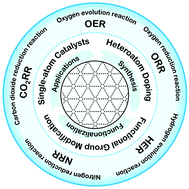Recent advances of graphdiyne: synthesis, functionalization, and electrocatalytic applications
Abstract
With unique sp-, sp2-hybridized carbon atoms, natural band gap, highly conjugated π electrons and uniform pore structure, graphdiyne (GDY) has been receiving increased attention and is predicted to have good application prospects in many fields. Recently, considerable efforts have been devoted to the controllable synthesis, structural modification and practical applications of GDY. For instance, GDY with different morphologies and spatial structures (nanotubes, nanowires, nanowalls, nanoribbons, few-layer nanosheets, etc.) has been successfully synthesized, the functionalization strategies (heteroatom doping/codoping, organic functional group grafting, etc.) for GDY are also greatly enriched, and electrocatalysts based on GDY have also been developed vigorously. Despite a series of achievements, there are still several urgent challenges in the development of GDY, including the precise synthesis, advanced structure characterization and investigation of the structure–performance correlation of GDY-based materials. Herein, we systematically summarize the research progress in the synthesis and modification of GDY in recent years and pay special attention to updating the discoveries of GDY-based materials in the field of electrocatalysis.

- This article is part of the themed collections: 2021 Materials Chemistry Frontiers Review-type Articles and Graphyne


 Please wait while we load your content...
Please wait while we load your content...